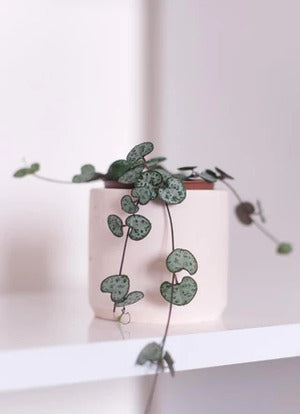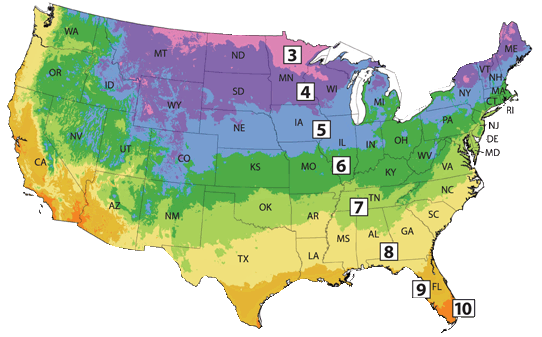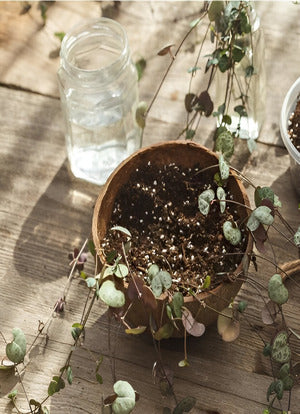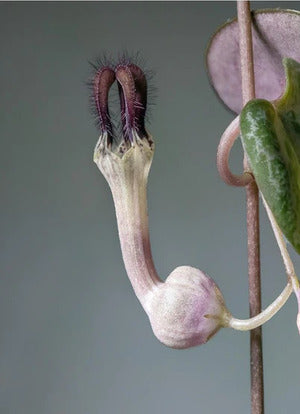String of Hearts 'Care & Growing Guide' - Everything You Need to Know!
Updated: January 28, 2025

String of Hearts is a popular household hanging plant with heart-shaped leaves that has won the hearts of millions of people worldwide. The string of hearts, scientifically known as Ceropegia woodii. This attractive succulent is best used for decoration purposes, especially in interior design.
Though commonly called the string of hearts plant, this botanical gift has several titles such as chain of hearts, sweetheart wine, rosary wine, collar of hearts, necklace vine, hearts entangled (because it gets tangled very quickly), and much more.
Native to South Africa, Zimbabwe, Swaziland, and Eswatini, its scientific name, Ceropegia woodii, pays homage to the botanist John Medley Wood, who first discovered its ethereal beauty in 1881. The string of hearts produces small, tubular flowers that are typically purple or pink in color and have a distinct fragrance.
About String of Hearts Plant

The String of Hearts plant is a unique, attractive house plant with evergreen, trailing vines that can grow up to 12 feet long.
Its delicate vines cascade down, adorned with a mesmerizing array of heart-shaped leaves. This is the enchanting String of Hearts plant, a true botanical wonder that will leave you in awe.
With its trailing tendrils, the String of Hearts adds a touch of magic to any space. Its foliage is a work of art, featuring shades of green, silver, and even shades of purple.
Each leaf is a perfect heart, as if Mother Nature herself sculpted them with love and care.
It's easy to care for, especially during warmer months, and can go dormant in cooler weather.
The string of hearts is a houseplant that is popular in hanging baskets but can also be grown as a ground cover, rock garden, or wall plant in warm Mediterranean climates, preferring a western or southern-facing window.
In this comprehensive guide from Planet Desert, we'll cover everything you need to know about your stunning string of hearts - from its watering needs to how to propagate it by cuttings and more. So, hop on over, and let's get started!
String of Hearts Care
Though the string of hearts plant needs minimal care, a few factors must be kept in mind to get the long-lasting best growth results. With proper care, this trailing plant can grow in hanging baskets indoors or outdoors.
Quick Reference

Bloom Season

Flower Color

Growth Rate

Hardiness Zone

Mature Size

Plant Type

Sun Exposure

Toxicity

Watering Needs
How Often to Water String of Hearts: Tips & Tricks
When it comes to watering your lovely String of Hearts plant, it's important to find the right balance. Overwatering can lead to root rot, so it's best to let the soil dry out between waterings.
Remember, this drought-tolerant String of hearts plants store water in their leaves and stems. This adaptation allows it to tolerate periods of drought. So, it's better to underwater than to overwater your chain of hearts. When you do water, make sure to give it a thorough soak, allowing the water to flow out of the drainage holes at the bottom of the pot.
Pro Tip
Stick your finger about an inch into the soil, and if it feels dry, then it's time to water. However, if it still feels slightly moist, it's better to hold off on watering for a little longer.
In the spring and summer, during the actively growing season; one can water them when a 2/3rd of the soil is dry or once in 2-3 weeks. However, as the weather cools down in fall and winter, you'll want to reduce the frequency of watering to prevent your growing string of hearts plant from sitting in overly wet soil. It is suggested not to water the leaves as, in some cases, it can cause water damage. Try to keep its leaves dry as much as possible.
Understanding the String of Hearts Light Requirements
Ceropegia woodii is a light-loving plant but does not like direct sunlight. For satisfactory growth, pay attention to the string of heart light requirements.
If growing indoors, keep it near the window where the leaves can soak the light for about four to six hours daily. If you don't have a window with bright, indirect light, you can also use artificial grow lights to provide the necessary light for your String of Hearts. Just make sure to keep the lights a few feet away from the plant to prevent heat damage.

If growing outdoors, then it is recommended to keep your string of hearts plants away from direct sun with the help of some shade. Keep an eye on your heart plant to ensure it's getting the right amount of light.
- If you notice the leaves becoming pale or stretching towards the light, it may be an indication that it needs more light.
- On the other hand, if the leaves start turning yellow or brown, it could be a sign of too much sunlight.
By providing your String of Hearts with the right amount of bright, indirect light, you'll help it thrive and maintain its beautiful appearance!
The Best Soil & Balanced Fertilizer For Your Hanging Succulent
When it comes to choosing the right soil for your string of hearts plant it's important to be cautious. This is because the amount of moisture in the soggy soil can be the primary reason for the early death of most succulents and cacti.
For a string of heart succulents, the soil should not be too wet because it can cause root rot.
If you're using regular potting soil, you'll need to add things like pumice or perlite to make sure there is enough drainage.
Here at Planet Desert, we have a specialized succulent soil that contains 5 natural substrates and organic mycorrhizae to promote the development of a strong root system that helps your succulent to thrive.

As an okay alternative, you can create your own potting mix soil at home, that is if you don't mind getting a bit of dirt on your hands and you are okay with a mediocre soil mix. If so, simply combine healthy natural garden soil with equal parts of sand or perlite.
As for fertilizer, the String of Hearts prefers a balanced, water-soluble natural fertilizer (NPK) with an equal amount of about 5-10-5. Apply the fertilizer once a year during the active growing season, which is typically spring. During fall and winter, when the heart plant goes into a period of dormancy, you can stop fertilizing.
Remember to always avoid over-fertilizing, as this can lead to salt buildup in the soil. It's better to err on the side of caution and under-fertilize than to risk damaging your string of hearts plant.
Finding the Ideal Temperature For String of Hearts
When growing indoors, the string of hearts plant prefers a warm temperatures between 60 to 85°F. You should consider planting it in the summer and spring. It's important to avoid extreme temperature fluctuations and drafts, as this can stress the Ceropegia plant and affect its growth.

For outdoor cultivation, it is hardy in USDA zones 10–11. These succulents can withstand temperatures as low as 20 degrees Fahrenheit for brief periods of time, but they cannot withstand prolonged exposure to the cold, especially if they have not retained enough moisture.
If you live in a colder climate, you can still enjoy this beautiful plant indoors as a houseplant.
When it comes to humidity, it can tolerate average household humidity levels, but it appreciates a slightly more humid environment. If the air in your home is particularly dry, you can increase the humidity around the heart plant by using a humidifier or placing a tray of water near it.
By providing your String of Hearts with the right temperature range and maintaining a comfortable humidity level, you'll create an ideal environment for this lovely chain of heart plants to thrive!
String of Hearts Flowers & Blooming Tips

The flowers of the String of Hearts are typically small and have a fascinating appearance. While it is primarily grown for its trailing vines and heart-shaped leaves, it does produce interesting flowers.
One of its common names—the rosary vine—comes from its tubular shape flowers and length of about an inch, with a bulbous base that forms into enclosed beads.
The tiny lantern flower has small, downward-pointing hairs and a light pink or purple color that makes it look like an upside-down umbrella.
The string of hearts blooming begins from summer to fall, although they can appear at other times throughout the year.
One interesting fact about the String of Hearts flowers is that they have a unique mechanism for attracting pollinators. The flowers produce a subtle, pleasant fragrance that can attract bees, butterflies, flies, or hummingbirds. The small hairs inside the flower trap the visiting insects, ensuring effective pollination.
 Butterflies
Butterflies
 Bees
Bees
 Hummingbirds
Hummingbirds
 Lady Bugs
Lady Bugs
 Multi Pollinators
Multi Pollinators
 Other Birds
Other Birds
It's important to note that while the string of heart plant flowers is beautiful, they are relatively rare to see in indoor settings. The String of Hearts plant requires specific conditions, enough light, and proper care to encourage flowering. Additionally, the flowers are relatively short-lived, typically lasting only a few days to a week.
Our Favorite Types of String of Hearts Plant
As we discussed above, indoor plants have several variations of this sweetheart vine, 'Ceropegia woodii', and the identification is based on the colors of the leaves and shapes. The most common one can be recognized as having perfectly heart-shaped leaves in a dark green color with veins usually visible in the pale shade of green. Along with that, the stem is of dark pinkish and red colors.

1
String of Hearts Plant 'Ceropegia woodii'
BUY AT PLANET DESERTkeypoints:
- USDA Hardiness Zones: 10, 11, 12
- Blooming Period: Late Summer, early autumn
- Mature Size: 12 ft. long
- Flower Color: Pink, purple
The String of Hearts plant, also known as Ceropegia woodii, is a popular trailing succulent with delicate heart-shaped leaves that cascade down in long vines. This plant is native to South Africa and is loved for its unique appearance and easy care requirements. It thrives in bright indirect light and prefers well-draining soil to prevent root rot. The String of Hearts plant is a great choice for hanging baskets or trailing over shelves, adding a touch of whimsy to any indoor space. With proper care, this plant can grow long vines adorned with clusters of small pink or purple flowers, making it a charming addition to any plant collection. Learn more...

2
Variegated String of Hearts (Ceropegia woodii variegata)
BUY AT PLANET DESERTkeypoints:
- USDA Hardiness Zones: 11, 12
- Blooming Period: Late winter, early spring
- Mature Size: 12 ft. long
- Flower Color: Pink, purple
Growing this Ceropegia woodii variegata, also known as variegated string of hearts, is the best choice if someone is bored with the green-colored leaves. The leaves and the plant stem are in pink and purple shades, with a tint of green in the middle of the leaves. With its variegated leaves, it can grow up to 12 feet long. It's a popular houseplant and can be grown in bright, indirect light. Learn more...

3
Silver Glory String of Hearts (Ceropegia woodii 'Silver Glory')
keypoints:
- USDA Hardiness Zones:10,11, 12
- Blooming Period: Spring, fall
- Mature Size:4 ft. long
- Flower Color: Pink
Ceropegia woodii 'Silver Glory' is a stunning variety of the popular Ceropegia woodii plant. Its unique feature lies in its silver-hued leaves, which add a touch of elegance to any space. This trailing succulent has delicate, heart-shaped foliage that cascades gracefully from hanging baskets or shelves. Its compact size of about 4 feet long; makes it an ideal choice for small indoor gardens or terrariums. This variety is very similar to the general one, but the major difference is that the leaves are not pointed from the topiary frame bottom, as the heart leaves of this plant are curved from below.

4
String of Spades (Ceropegia woodii 'Heartless' )
keypoints:
- USDA Hardiness Zones: 10, 11, 12
- Blooming Period: Spring, Summer
- Mature Size: 4 ft. long
- Flower Color: Pink, Purple
Ceropegia woodii 'Heartless' is a unique and fascinating plant known for its trailing vines and heart-shaped leaves. Unlike its counterparts, this particular variety lacks the characteristic heart-shaped leaf pattern, giving it a distinctive appearance. With its delicate, trailing stems and small, fleshy leaves, 'Heartless' adds a touch of whimsy to any indoor or outdoor space. The heart-shaped succulent plant's leaves resemble the spade shape of a deck of cards. The stems are a mix of shades like red, orange, and brown. The leaves sit flat on them.

5
String of Needles (Ceropegia linearis subsp. woodii)
keypoints:
- USDA Hardiness Zones: 11, 12
- Blooming Period: Summer, early fall
- Mature Size: 6 ft. long
- Flower Color: White, pale magenta
Unlike other varieties, this Ceropegia linearis subsp. woodii has more needle-shaped leaves. Not all varieties of the heart vine plant have heart-shaped leaves. It can be mildly toxic when consumed and can cause nausea, vomiting, and headaches. Its leaves have a beautiful lawn green shade, and the stem is a red color, which can make the plant useful for decorative purposes.

6
Ceropegia woodii 'String of Arrows'
keypoints:
- USDA Hardiness Zones: 9, 10, 11
- Blooming Period: Summer, fall
- Mature Size: 3 ft. long
- Flower Color: White, pink
The Ceropegia Woodii ‘String of Arrows’ is the variety of string of heart plant that comes with pointed and sharp leaves from the bottom, as their leaves depict more of a triangular shape than the heart one. The leaves are in dark and pale shades of green, along with greenish and brownish stems, which truly shows that it is not as colorful as the other types of heart plants.
Pruning of String of Hearts Plant
When it comes to pruning the String of Hearts plant, it's a good idea to give it a little trim every now and then. This helps keep the plant looking neat and encourages new growth. You can prune back any leggy or overgrown stems to promote a fuller, bushier appearance. Just make sure to use clean, sharp scissors or pruning shears to avoid damaging the plant.
Don't be afraid to get a little creative with your pruning and shape the roots poke your heart string plant to your liking. Remember, pruning is like giving your String of Hearts a little haircut to keep it looking its best!
Pro Tip
Remember, cut below the node where a group of leaves emerges from the stem. You can cut or trim this heart plant string as much as you desire because it can withstand hard trimming.
Potting & Repotting of String of Hearts Plant
For potting, choose a well-drained pot that's slightly larger than the current pot. Fill the bottom with a layer of small stones or pebbles to improve drainage.
Then, use a well-draining soil mix, like a combination of regular potting soil and perlite or sand.
Gently remove the plant from its same pot, being careful not to damage the roots, and place it in the new pot. Fill in the gaps with soil and lightly press it down to secure the plant.
As for repotting, you'll typically need to repot your String of Hearts every 1-2 years, or when you notice the roots becoming crowded. Spring is usually the best time to repot, as the plant is entering its active growing phase.

Follow the same steps as potting but be mindful not to overpot. The plant prefers to be slightly root-bound, so choose a pot that's only slightly larger than the current one.
Remember to water your new plants or newly potted or repotted plant thoroughly and then allow the soil to dry out slightly before watering again. With proper potting and repotting, your String of Hearts will have the space it needs to grow and thrive!
String of Hearts Propagation: A Step-by-Step Guide
To propagate string of hearts; it can be quickly done by three ways, i.e., via seeds, stem cuttings, and small tubers together. The soil for a string of hearts needs the correct sand, compost, and gardening soil ratio. Also, both pot and soil should have a sound drainage system, and the best season to start a chain of heart propagation is during spring and summer.
Water Propagation Method
- To propagate using the water method, take a healthy stem cutting with a few nodes and remove the bottom set of leaves.
- Place the cutting in a glass of water, making sure the nodes are submerged.
- Keep the glass in a bright, indirect light location and change the water every few days.
- After a few weeks, you should start to see roots forming. When the roots are about an inch long, move the cutting to a pot with well-draining soil.
The Butterfly Method
- This butterfly method involves burying a section of the stem directly into the soil to encourage root growth.
- Take a stem cutting with a few nodes and remove the bottom set of leaves.
- Make a small hole in the soil and insert the stem, leaving the nodes exposed.
- Gently press the soil around the stem to secure it. Keep the soil slightly moist and place the pot in a bright, indirect light location.
- Roots should start to form in a few weeks, and you can then treat it like a regular String of Hearts plant.
- Many gardeners love using the Butterfly Method for propagation because it has a higher chance of growing vines on either side of the cutting.
Tuber Propagation Method
- The tuber method is a unique way to propagate String of Hearts plants. Look for any bead-like aerial tubers that have formed on the stems of your plant.
- Carefully remove the tuber and plant it in a pot with well-drained soil.
- Keep the soil slightly moist and provide bright, indirect light.
- The tuber will develop roots and eventually grow into a new plant.
- Once it grows root you can cut the vine from the mother plant.

Remember, patience is key when propagating plants. It may take some time for roots to form, so be patient and give your cuttings or tubers the care they need. Good luck with your propagation adventures!
Overwintering String of Hearts
To ensure your plant grows and stays healthy during the colder winter months, it's important to reduce watering and let the soil dry out a bit between waterings. Find a cool spot for your plant with temperatures around 50-60°F to mimic its natural winter conditions. And don't forget to place it in a spot that still gets bright, indirect light. With these steps, your String of Hearts will be ready to thrive and bring joy to your space all winter long!
Common Pests & Problems of String of Hearts Plant

The string of hearts plants are relatively low maintenance, but they can still face some common pests and problems that gardeners should be aware of.
Mealybugs: These tiny white insects can infest the plant, leaving a cotton-like substance on the leaves. Use a cotton swab dipped in rubbing alcohol or neem oil to remove them.
Spider mites: These tiny pests can create webs and cause yellowing or speckled leaves. Regularly misting your string of hearts and keeping humidity levels up can help prevent them.
Root rot: Overwatering can lead to root rot, causing the plant's roots to become mushy and black. Ensure the soil has good drainage and only use room temperature water when the top inch of soil is dry.
Yellowing leaves: This can be a sign of overwatering or underwatering. Adjust your watering routine accordingly and make sure the plant is receiving adequate light.
Curling Leaves: If your plants are underwater, schedule a regular watering routine and gradually reintroduce water for a week to help them rebound. Avoid overwatering, as too much water can shock and kill the plant.
Leaf Drop: Chain of hearts plants can drop leaves for a variety of reasons, including overwatering, underwatering, or exposure to extreme temperatures. If you notice your plant dropping leaves, it's important to identify the underlying cause and take steps to correct it.
Remember, keeping a close eye on your String of Hearts and promptly addressing any issues can help keep it happy and thriving!
Where to Buy String of Hearts?
If you're looking to buy a String of Hearts plant, you're in luck! You can find them at various nurseries and plant shops. Additionally, if you prefer the convenience of online shopping, you can definitely order them online too. Planet Desert is a fantastic nursery where you can find a wide selection of succulent plants, including the String of Hearts for sale. Where we have over 500 succulents and Cacti to choose from, so you'll definitely find something to add to your collection.
String of Hearts Quick Growing Reference Guide
| Botanical Name | Ceropegia woodii |
|---|---|
| Bloom Season | Summer, Fall |
| Common Name | String of hearts, Chain of hearts, sweetheart wine, rosary wine, collar of hearts, necklace vine, hearts entangled |
| Plant Type | Trailing / Hanging, Succulent |
| Sun Exposure | Partial shade |
| Water Needs | Low |
| Flower Color | Light Pink, Purple |
| Soil Type | Succulent Soil Mix |
| Hardiness Zone | 9, 10, 11, 12 |
| Mature Size | 12 feet long |
| Toxicity | Safe for Humans, friendly to dogs, friendly to cats |
Final Thoughts
Overall, the String of Hearts plant is a delightful experience for any plant lover. Whether you're a newbie or a seasoned plant parent, these charming trailing vines are sure to captivate your heart. To ensure the well-being of your String of Hearts, remember to provide it with bright, indirect light, well-draining soil, and moderate watering.
Keep an eye on its delicate tendrils and give it a gentle trim when needed. With a little love and attention, your String of Hearts will flourish and bring beauty to your space. So go ahead, bring home this enchanting plant and enjoy the joy it brings into your life!
Frequently Asked Questions
-
How do you care for a string of hearts?
String of Hearts is an easy-to-care-for trailing plant that prefers bright, indirect light near filtered sunlight. To avoid overwatering, let the soil dry between waterings. This drought-tolerant plant prefers underwater watering. A well-draining potting mix is recommended to prevent root rot. String of Hearts doesn't require frequent fertilization, but a balanced houseplant fertilizer can be used in the spring. They can be grown outdoors in USDA zones 10-11.
-
Why are strings of hearts so expensive?
String of Hearts plants can sometimes be more expensive due to their popularity and unique appearance. The variegated varieties, like the String of Hearts Variegata, can be particularly sought after and therefore priced higher. The variegated factors contribute to their higher price compared to other houseplants. However, you can always keep an eye out for sales or check with local plant nurseries for more affordable options.
-
Does a string of hearts grow fast?
The String of Hearts is a long-lived and fast-growing plant that can reach heights of about 12 feet. It's impressive to see those cascading vines stretch out and create a beautiful display. Just make sure to give it the right conditions and care for optimal growth.
-
Is String of Hearts rare?
Yes, the variegated String of Hearts plant (Ceropegia woodie variegata), is considered to be a relatively rare and sought-after houseplant. Its unique trailing vines adorned with heart-shaped leaves make it a popular choice among plant enthusiasts. Additionally, its delicate appearance and ability to thrive in low-light conditions contribute to its desirability among collectors.
-
Why is my string of hearts turning purple?
The leaves of variegated string of hearts can naturally have a purplish hue, especially when exposed to bright light. This can be a sign that your plant is getting the right amount of sunlight. However, if the purple color is accompanied by other signs of distress to your string of heart, such as wilting or browning, it could indicate an issue with watering or light intensity. It's always a good idea to assess the overall health of the plant and adjust care accordingly. Keep an eye on it and make sure it's getting the right balance of light and water.
-
How to propagate a string of hearts?
There are a few methods you can try to propagate your String of Hearts. One popular method is the water propagation method. Simply take a healthy stem cutting, remove a few of the lower leaves, and place the cutting in a jar of water. Change the water every few days and wait for roots to develop. Another method is the butterfly method, where you press a section of the stem into the soil and secure it with a paperclip or hairpin until it roots. Lastly, you can also propagate by tuber division, where you carefully separate the tubers and plant them in a well-draining soil mix. Whichever method you choose, make sure to provide the right conditions for the cuttings to root, such as bright indirect light and regular watering.
-
Is the string of hearts toxic to cats?
The String of Hearts (Ceropegia woodii) is actually considered to be non-toxic to cats. So, you don't have to worry about your furry friend getting sick if they come into contact with this plant. It's always best to keep plants that are toxic to pets out of their reach to ensure their safety.


























